Assessment 1: Customer Service Plan for Online Retailer Redbubble
VerifiedAdded on 2020/04/07
|14
|2646
|58
Report
AI Summary
This report presents an assessment of a customer service plan, focusing on the online art marketplace Redbubble. It begins with Redbubble's mission statement and then delves into the RATER model (Reliability, Assurance, Tangibles, Empathy, Responsiveness) to evaluate customer service delivery. The report outlines a customer service plan, identifying customer needs and research methods, including questionnaires. It assesses the plan's alignment with customer agreements and discusses questionnaire design and results. Furthermore, the report examines relevant consumer protection legislation, including the Competition and Consumer Act 2010, Australian Consumer Law, Fair Trading Act 2010 (WA), and the Spam Act 2003, highlighting their importance in safeguarding consumer rights. The analysis provides a comprehensive overview of customer service strategies and legal considerations within the context of an online retail environment.
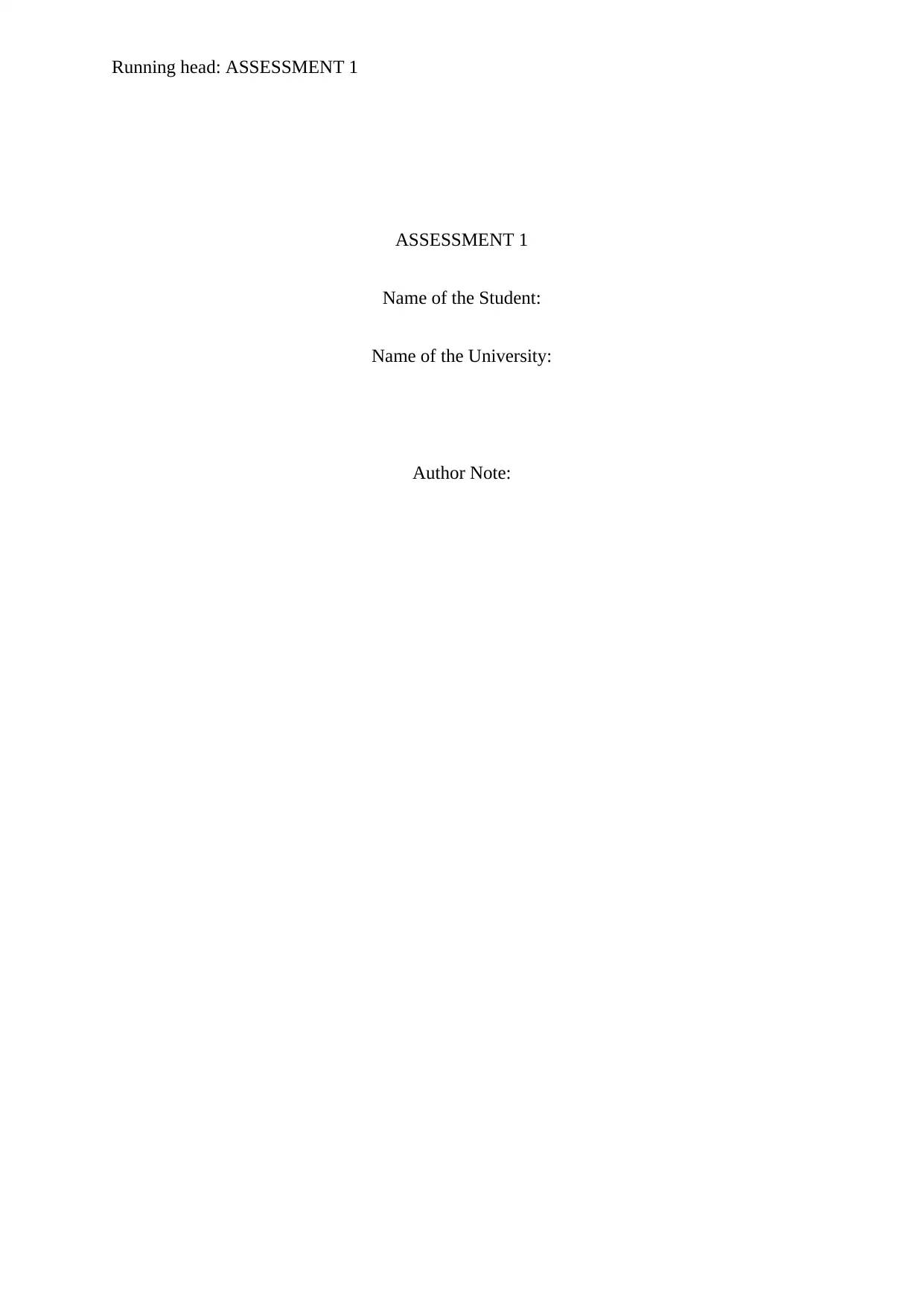
Running head: ASSESSMENT 1
ASSESSMENT 1
Name of the Student:
Name of the University:
Author Note:
ASSESSMENT 1
Name of the Student:
Name of the University:
Author Note:
Paraphrase This Document
Need a fresh take? Get an instant paraphrase of this document with our AI Paraphraser
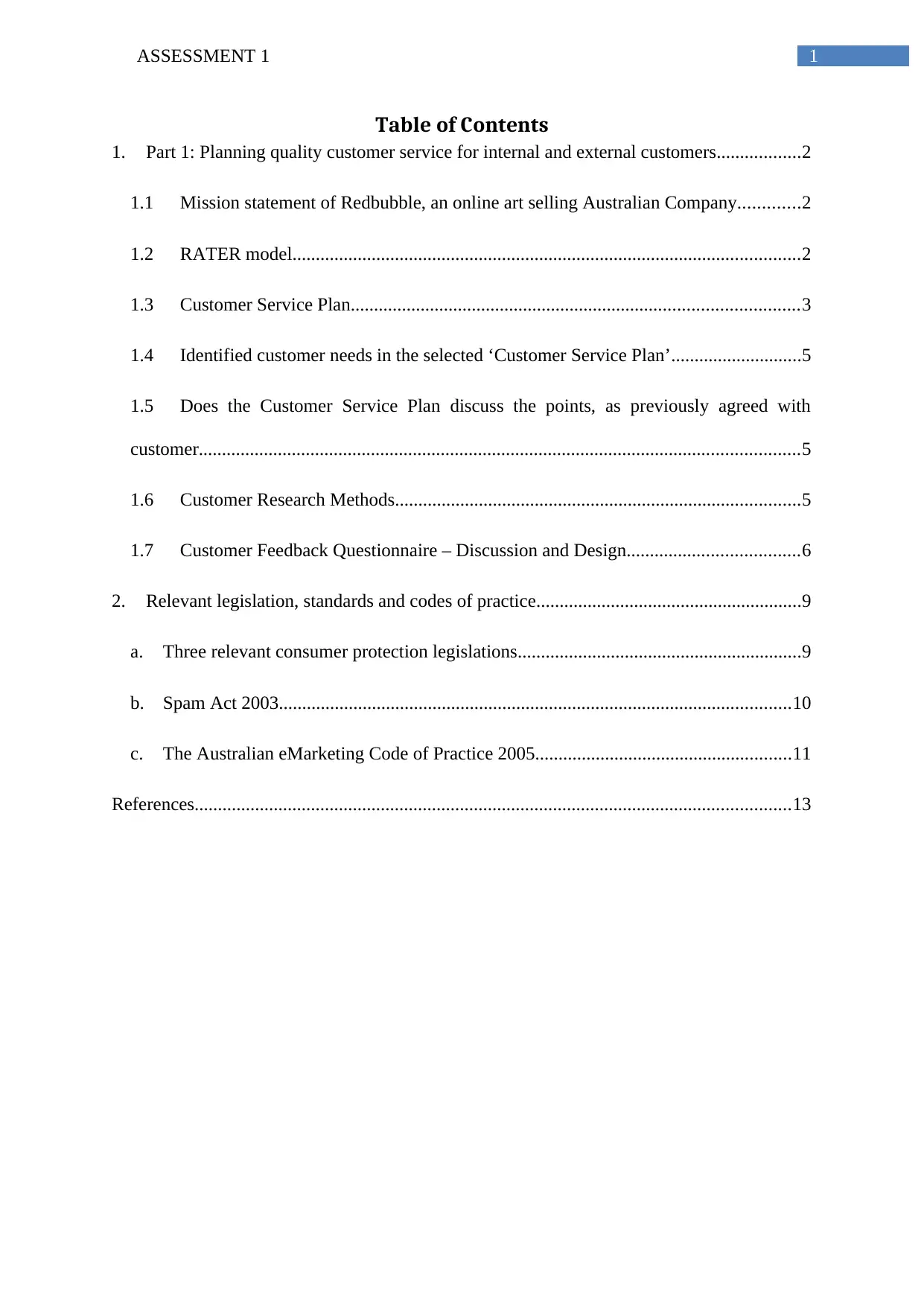
1ASSESSMENT 1
Table of Contents
1. Part 1: Planning quality customer service for internal and external customers..................2
1.1 Mission statement of Redbubble, an online art selling Australian Company.............2
1.2 RATER model.............................................................................................................2
1.3 Customer Service Plan................................................................................................3
1.4 Identified customer needs in the selected ‘Customer Service Plan’............................5
1.5 Does the Customer Service Plan discuss the points, as previously agreed with
customer.................................................................................................................................5
1.6 Customer Research Methods.......................................................................................5
1.7 Customer Feedback Questionnaire – Discussion and Design.....................................6
2. Relevant legislation, standards and codes of practice.........................................................9
a. Three relevant consumer protection legislations.............................................................9
b. Spam Act 2003..............................................................................................................10
c. The Australian eMarketing Code of Practice 2005.......................................................11
References................................................................................................................................13
Table of Contents
1. Part 1: Planning quality customer service for internal and external customers..................2
1.1 Mission statement of Redbubble, an online art selling Australian Company.............2
1.2 RATER model.............................................................................................................2
1.3 Customer Service Plan................................................................................................3
1.4 Identified customer needs in the selected ‘Customer Service Plan’............................5
1.5 Does the Customer Service Plan discuss the points, as previously agreed with
customer.................................................................................................................................5
1.6 Customer Research Methods.......................................................................................5
1.7 Customer Feedback Questionnaire – Discussion and Design.....................................6
2. Relevant legislation, standards and codes of practice.........................................................9
a. Three relevant consumer protection legislations.............................................................9
b. Spam Act 2003..............................................................................................................10
c. The Australian eMarketing Code of Practice 2005.......................................................11
References................................................................................................................................13
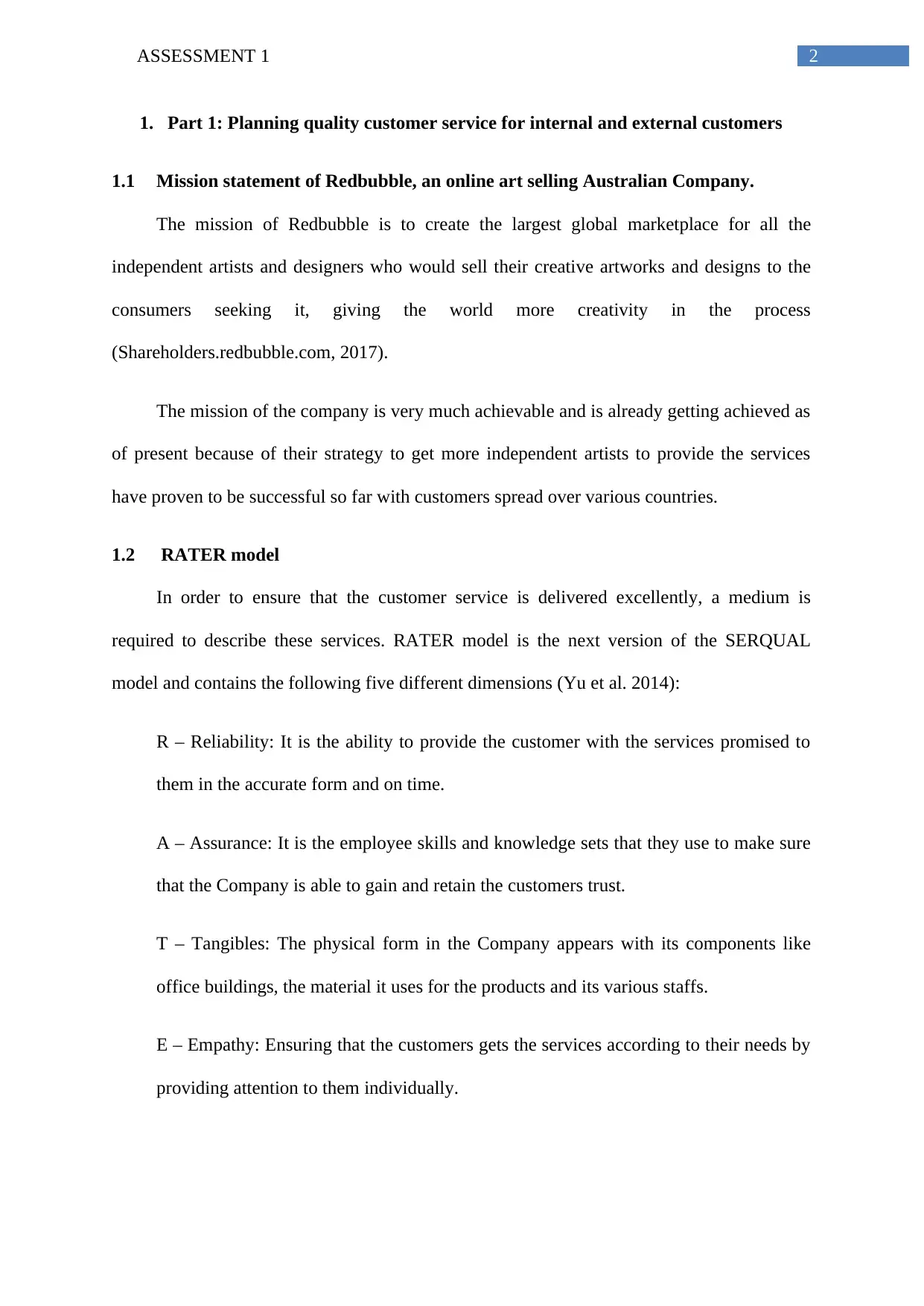
2ASSESSMENT 1
1. Part 1: Planning quality customer service for internal and external customers
1.1 Mission statement of Redbubble, an online art selling Australian Company.
The mission of Redbubble is to create the largest global marketplace for all the
independent artists and designers who would sell their creative artworks and designs to the
consumers seeking it, giving the world more creativity in the process
(Shareholders.redbubble.com, 2017).
The mission of the company is very much achievable and is already getting achieved as
of present because of their strategy to get more independent artists to provide the services
have proven to be successful so far with customers spread over various countries.
1.2 RATER model
In order to ensure that the customer service is delivered excellently, a medium is
required to describe these services. RATER model is the next version of the SERQUAL
model and contains the following five different dimensions (Yu et al. 2014):
R – Reliability: It is the ability to provide the customer with the services promised to
them in the accurate form and on time.
A – Assurance: It is the employee skills and knowledge sets that they use to make sure
that the Company is able to gain and retain the customers trust.
T – Tangibles: The physical form in the Company appears with its components like
office buildings, the material it uses for the products and its various staffs.
E – Empathy: Ensuring that the customers gets the services according to their needs by
providing attention to them individually.
1. Part 1: Planning quality customer service for internal and external customers
1.1 Mission statement of Redbubble, an online art selling Australian Company.
The mission of Redbubble is to create the largest global marketplace for all the
independent artists and designers who would sell their creative artworks and designs to the
consumers seeking it, giving the world more creativity in the process
(Shareholders.redbubble.com, 2017).
The mission of the company is very much achievable and is already getting achieved as
of present because of their strategy to get more independent artists to provide the services
have proven to be successful so far with customers spread over various countries.
1.2 RATER model
In order to ensure that the customer service is delivered excellently, a medium is
required to describe these services. RATER model is the next version of the SERQUAL
model and contains the following five different dimensions (Yu et al. 2014):
R – Reliability: It is the ability to provide the customer with the services promised to
them in the accurate form and on time.
A – Assurance: It is the employee skills and knowledge sets that they use to make sure
that the Company is able to gain and retain the customers trust.
T – Tangibles: The physical form in the Company appears with its components like
office buildings, the material it uses for the products and its various staffs.
E – Empathy: Ensuring that the customers gets the services according to their needs by
providing attention to them individually.
⊘ This is a preview!⊘
Do you want full access?
Subscribe today to unlock all pages.

Trusted by 1+ million students worldwide

3ASSESSMENT 1
R – Responsiveness: the ability to respond to the customers providing them help as
quickly as possible.
Thus, by paying more attention and focus on the above five dimensions any business
will be able to investigate, identify, plan and deliver quality customer service.
1.3 Customer Service Plan
Every Company in order to survive well in the competitive market needs to ensure
that they know how to deal and approach their customers.
The chosen Customer Service Plan includes the following steps in it:
Assessment of the Customer Service provided
In this step, self assessment of the company’s work culture can done along
with the ability to solve the various problems by reviewing the complaints of the
customers. Hence, improving the whole process of provide the services and products
to the customers.
Understanding the needs and requirements of the customers
Here, the company can check and evaluate both internally from the company’s
available customers reports as well as from the third party vendors and products
suppliers and get a proper feedback on whether the customers’ requirements be it cost
or quality are getting met in the right way.
Creating an achievable Customer mission and the provided service policies
Making sure that the company mission is achieved by adopting effective
service policies that are in accordance with various existing legislations of the
R – Responsiveness: the ability to respond to the customers providing them help as
quickly as possible.
Thus, by paying more attention and focus on the above five dimensions any business
will be able to investigate, identify, plan and deliver quality customer service.
1.3 Customer Service Plan
Every Company in order to survive well in the competitive market needs to ensure
that they know how to deal and approach their customers.
The chosen Customer Service Plan includes the following steps in it:
Assessment of the Customer Service provided
In this step, self assessment of the company’s work culture can done along
with the ability to solve the various problems by reviewing the complaints of the
customers. Hence, improving the whole process of provide the services and products
to the customers.
Understanding the needs and requirements of the customers
Here, the company can check and evaluate both internally from the company’s
available customers reports as well as from the third party vendors and products
suppliers and get a proper feedback on whether the customers’ requirements be it cost
or quality are getting met in the right way.
Creating an achievable Customer mission and the provided service policies
Making sure that the company mission is achieved by adopting effective
service policies that are in accordance with various existing legislations of the
Paraphrase This Document
Need a fresh take? Get an instant paraphrase of this document with our AI Paraphraser
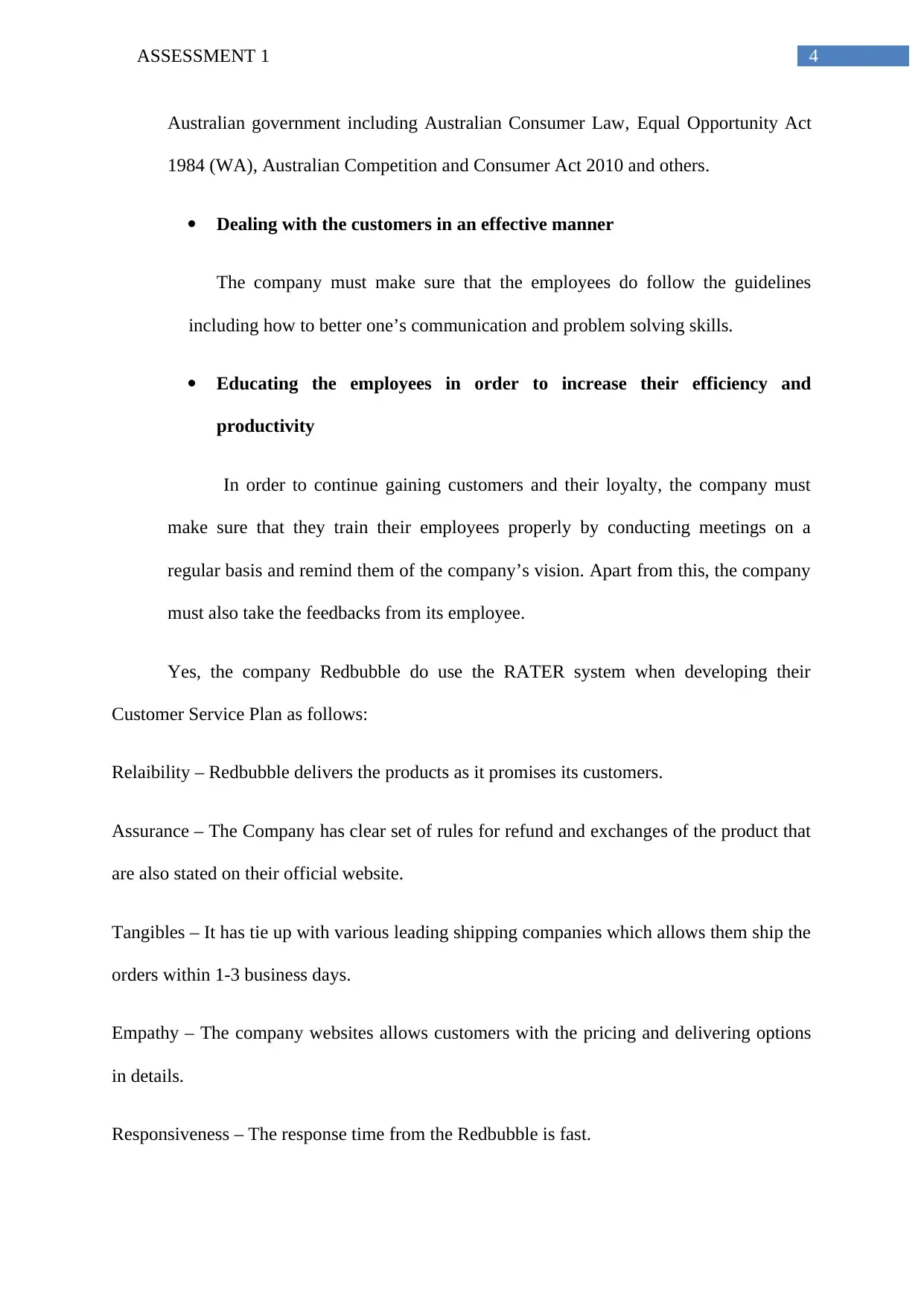
4ASSESSMENT 1
Australian government including Australian Consumer Law, Equal Opportunity Act
1984 (WA), Australian Competition and Consumer Act 2010 and others.
Dealing with the customers in an effective manner
The company must make sure that the employees do follow the guidelines
including how to better one’s communication and problem solving skills.
Educating the employees in order to increase their efficiency and
productivity
In order to continue gaining customers and their loyalty, the company must
make sure that they train their employees properly by conducting meetings on a
regular basis and remind them of the company’s vision. Apart from this, the company
must also take the feedbacks from its employee.
Yes, the company Redbubble do use the RATER system when developing their
Customer Service Plan as follows:
Relaibility – Redbubble delivers the products as it promises its customers.
Assurance – The Company has clear set of rules for refund and exchanges of the product that
are also stated on their official website.
Tangibles – It has tie up with various leading shipping companies which allows them ship the
orders within 1-3 business days.
Empathy – The company websites allows customers with the pricing and delivering options
in details.
Responsiveness – The response time from the Redbubble is fast.
Australian government including Australian Consumer Law, Equal Opportunity Act
1984 (WA), Australian Competition and Consumer Act 2010 and others.
Dealing with the customers in an effective manner
The company must make sure that the employees do follow the guidelines
including how to better one’s communication and problem solving skills.
Educating the employees in order to increase their efficiency and
productivity
In order to continue gaining customers and their loyalty, the company must
make sure that they train their employees properly by conducting meetings on a
regular basis and remind them of the company’s vision. Apart from this, the company
must also take the feedbacks from its employee.
Yes, the company Redbubble do use the RATER system when developing their
Customer Service Plan as follows:
Relaibility – Redbubble delivers the products as it promises its customers.
Assurance – The Company has clear set of rules for refund and exchanges of the product that
are also stated on their official website.
Tangibles – It has tie up with various leading shipping companies which allows them ship the
orders within 1-3 business days.
Empathy – The company websites allows customers with the pricing and delivering options
in details.
Responsiveness – The response time from the Redbubble is fast.
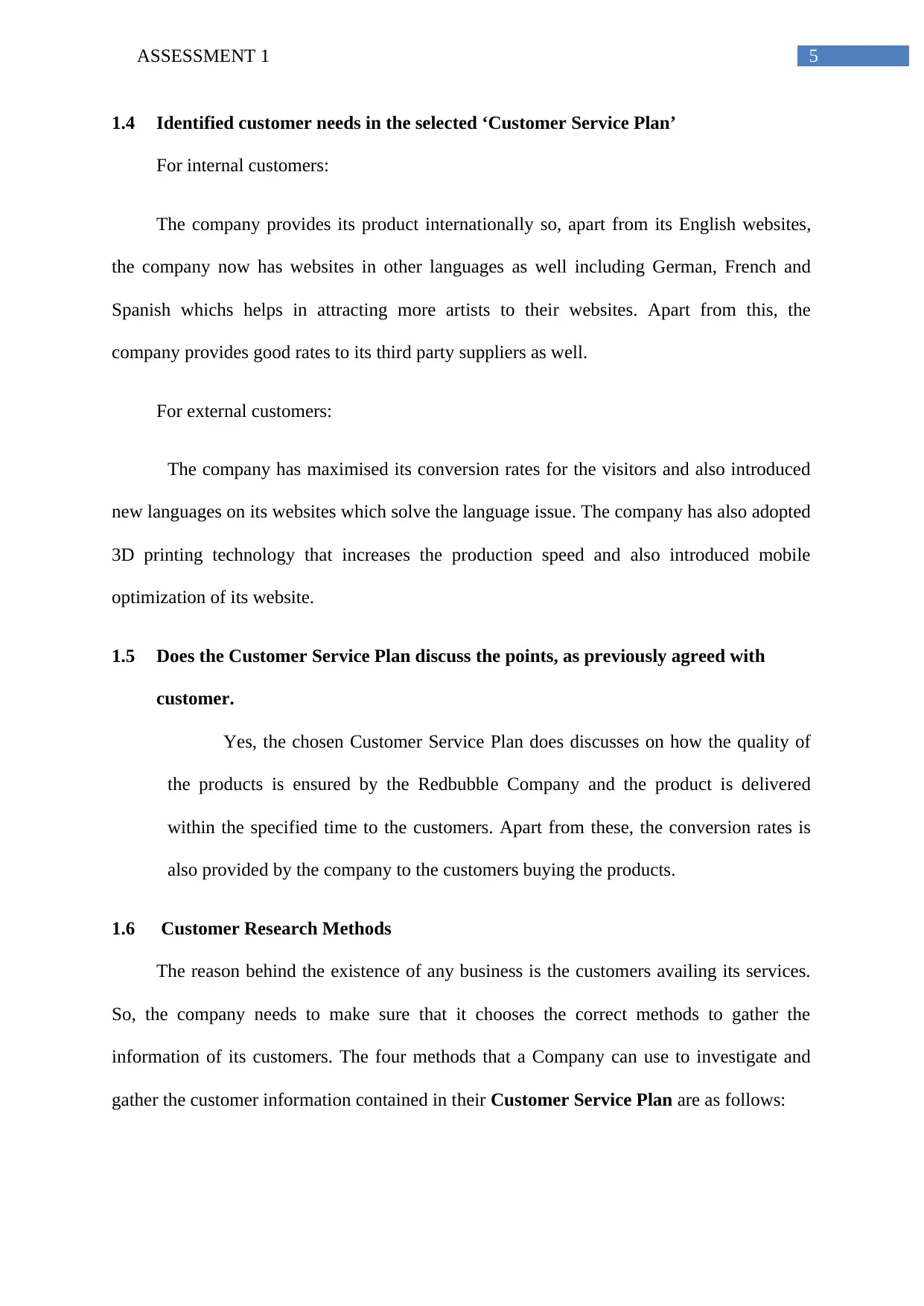
5ASSESSMENT 1
1.4 Identified customer needs in the selected ‘Customer Service Plan’
For internal customers:
The company provides its product internationally so, apart from its English websites,
the company now has websites in other languages as well including German, French and
Spanish whichs helps in attracting more artists to their websites. Apart from this, the
company provides good rates to its third party suppliers as well.
For external customers:
The company has maximised its conversion rates for the visitors and also introduced
new languages on its websites which solve the language issue. The company has also adopted
3D printing technology that increases the production speed and also introduced mobile
optimization of its website.
1.5 Does the Customer Service Plan discuss the points, as previously agreed with
customer.
Yes, the chosen Customer Service Plan does discusses on how the quality of
the products is ensured by the Redbubble Company and the product is delivered
within the specified time to the customers. Apart from these, the conversion rates is
also provided by the company to the customers buying the products.
1.6 Customer Research Methods
The reason behind the existence of any business is the customers availing its services.
So, the company needs to make sure that it chooses the correct methods to gather the
information of its customers. The four methods that a Company can use to investigate and
gather the customer information contained in their Customer Service Plan are as follows:
1.4 Identified customer needs in the selected ‘Customer Service Plan’
For internal customers:
The company provides its product internationally so, apart from its English websites,
the company now has websites in other languages as well including German, French and
Spanish whichs helps in attracting more artists to their websites. Apart from this, the
company provides good rates to its third party suppliers as well.
For external customers:
The company has maximised its conversion rates for the visitors and also introduced
new languages on its websites which solve the language issue. The company has also adopted
3D printing technology that increases the production speed and also introduced mobile
optimization of its website.
1.5 Does the Customer Service Plan discuss the points, as previously agreed with
customer.
Yes, the chosen Customer Service Plan does discusses on how the quality of
the products is ensured by the Redbubble Company and the product is delivered
within the specified time to the customers. Apart from these, the conversion rates is
also provided by the company to the customers buying the products.
1.6 Customer Research Methods
The reason behind the existence of any business is the customers availing its services.
So, the company needs to make sure that it chooses the correct methods to gather the
information of its customers. The four methods that a Company can use to investigate and
gather the customer information contained in their Customer Service Plan are as follows:
⊘ This is a preview!⊘
Do you want full access?
Subscribe today to unlock all pages.

Trusted by 1+ million students worldwide
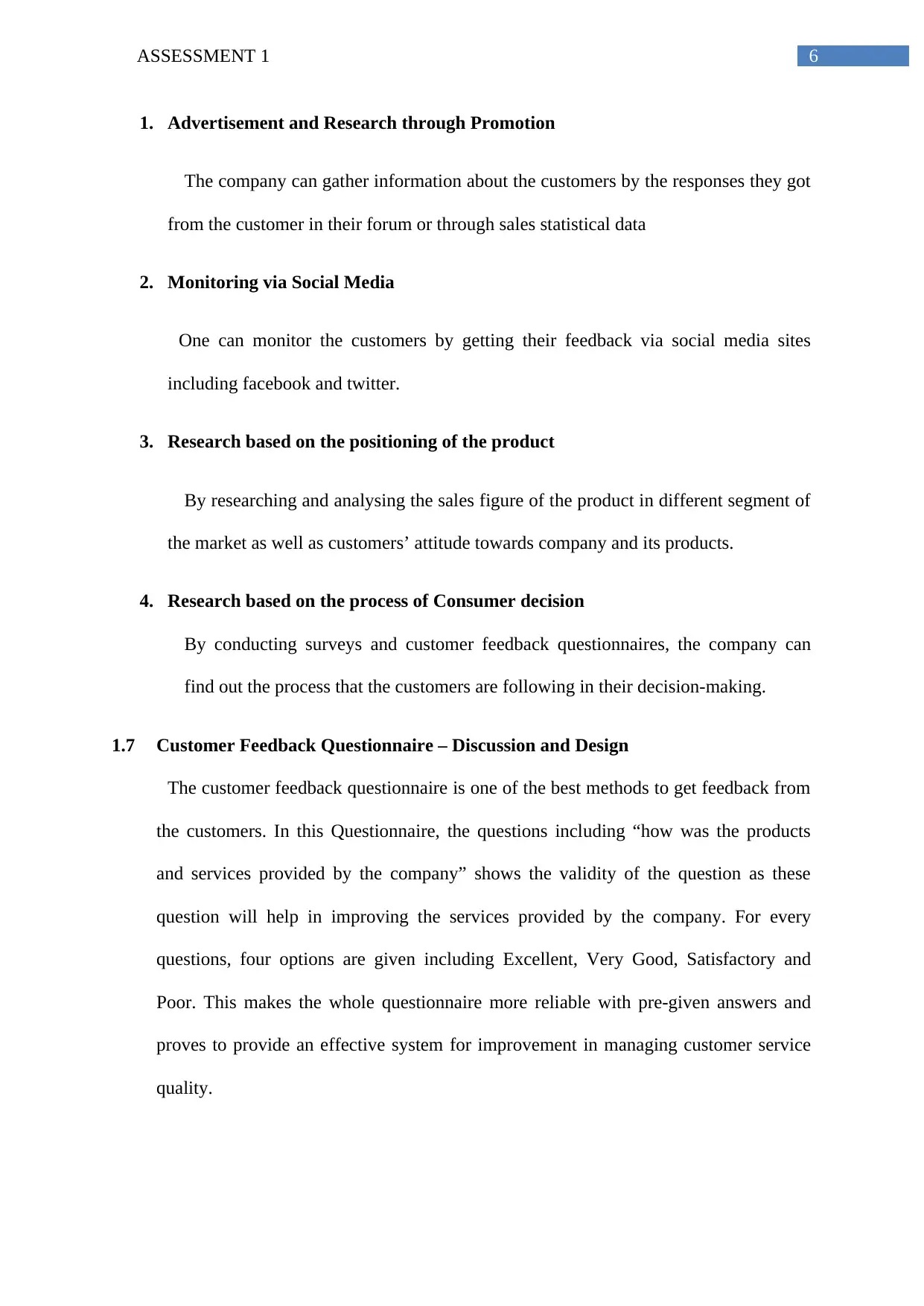
6ASSESSMENT 1
1. Advertisement and Research through Promotion
The company can gather information about the customers by the responses they got
from the customer in their forum or through sales statistical data
2. Monitoring via Social Media
One can monitor the customers by getting their feedback via social media sites
including facebook and twitter.
3. Research based on the positioning of the product
By researching and analysing the sales figure of the product in different segment of
the market as well as customers’ attitude towards company and its products.
4. Research based on the process of Consumer decision
By conducting surveys and customer feedback questionnaires, the company can
find out the process that the customers are following in their decision-making.
1.7 Customer Feedback Questionnaire – Discussion and Design
The customer feedback questionnaire is one of the best methods to get feedback from
the customers. In this Questionnaire, the questions including “how was the products
and services provided by the company” shows the validity of the question as these
question will help in improving the services provided by the company. For every
questions, four options are given including Excellent, Very Good, Satisfactory and
Poor. This makes the whole questionnaire more reliable with pre-given answers and
proves to provide an effective system for improvement in managing customer service
quality.
1. Advertisement and Research through Promotion
The company can gather information about the customers by the responses they got
from the customer in their forum or through sales statistical data
2. Monitoring via Social Media
One can monitor the customers by getting their feedback via social media sites
including facebook and twitter.
3. Research based on the positioning of the product
By researching and analysing the sales figure of the product in different segment of
the market as well as customers’ attitude towards company and its products.
4. Research based on the process of Consumer decision
By conducting surveys and customer feedback questionnaires, the company can
find out the process that the customers are following in their decision-making.
1.7 Customer Feedback Questionnaire – Discussion and Design
The customer feedback questionnaire is one of the best methods to get feedback from
the customers. In this Questionnaire, the questions including “how was the products
and services provided by the company” shows the validity of the question as these
question will help in improving the services provided by the company. For every
questions, four options are given including Excellent, Very Good, Satisfactory and
Poor. This makes the whole questionnaire more reliable with pre-given answers and
proves to provide an effective system for improvement in managing customer service
quality.
Paraphrase This Document
Need a fresh take? Get an instant paraphrase of this document with our AI Paraphraser
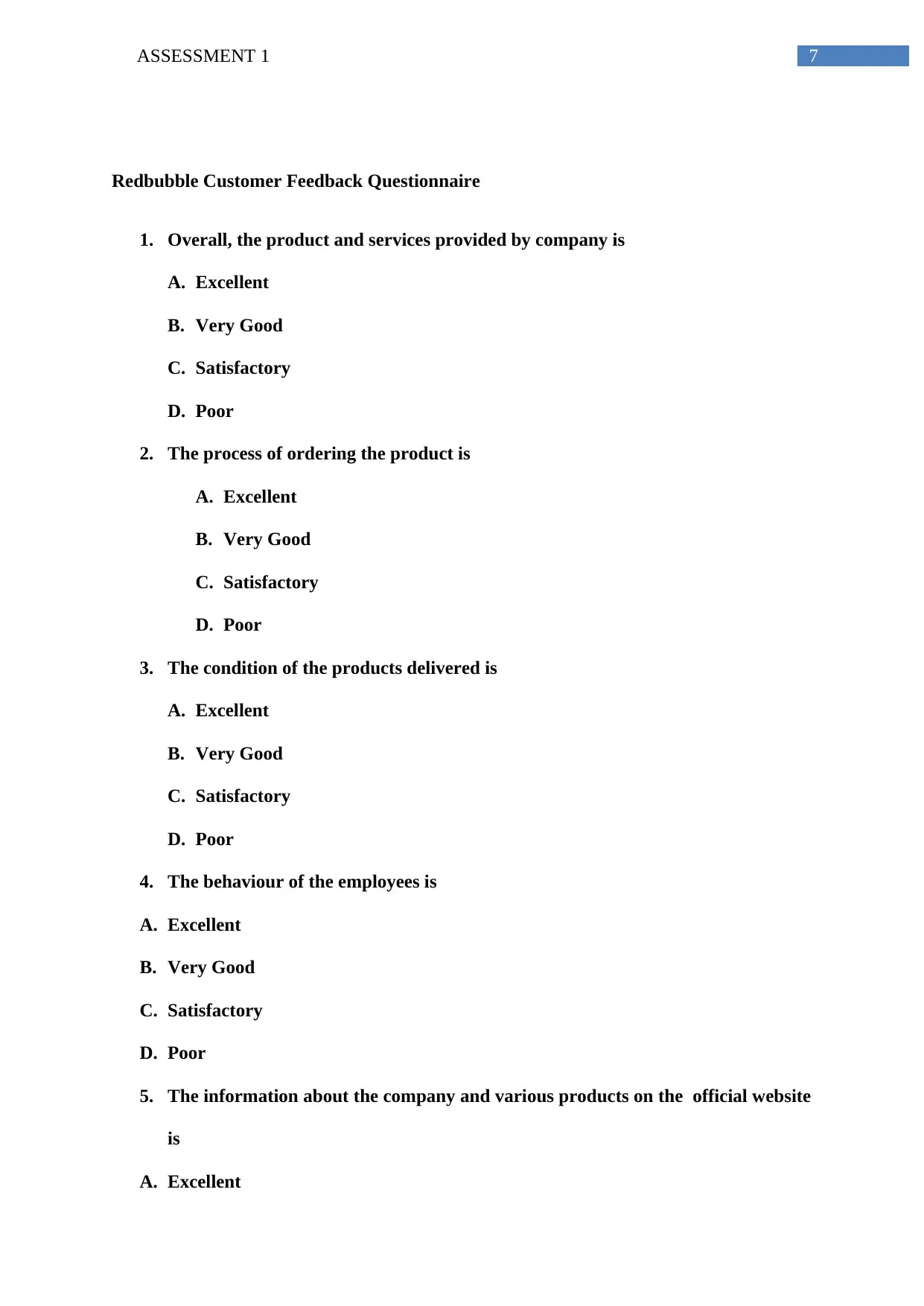
7ASSESSMENT 1
Redbubble Customer Feedback Questionnaire
1. Overall, the product and services provided by company is
A. Excellent
B. Very Good
C. Satisfactory
D. Poor
2. The process of ordering the product is
A. Excellent
B. Very Good
C. Satisfactory
D. Poor
3. The condition of the products delivered is
A. Excellent
B. Very Good
C. Satisfactory
D. Poor
4. The behaviour of the employees is
A. Excellent
B. Very Good
C. Satisfactory
D. Poor
5. The information about the company and various products on the official website
is
A. Excellent
Redbubble Customer Feedback Questionnaire
1. Overall, the product and services provided by company is
A. Excellent
B. Very Good
C. Satisfactory
D. Poor
2. The process of ordering the product is
A. Excellent
B. Very Good
C. Satisfactory
D. Poor
3. The condition of the products delivered is
A. Excellent
B. Very Good
C. Satisfactory
D. Poor
4. The behaviour of the employees is
A. Excellent
B. Very Good
C. Satisfactory
D. Poor
5. The information about the company and various products on the official website
is
A. Excellent
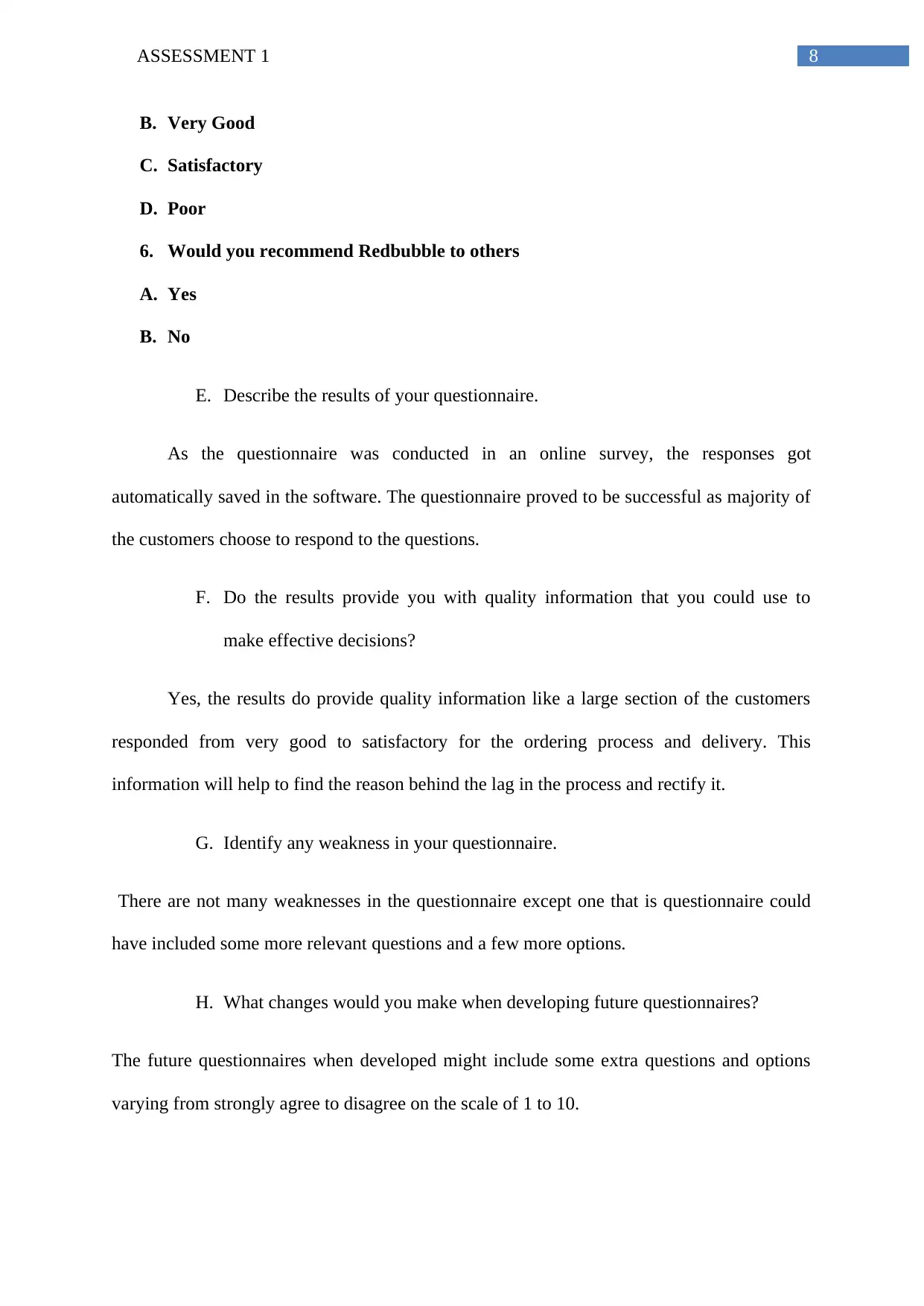
8ASSESSMENT 1
B. Very Good
C. Satisfactory
D. Poor
6. Would you recommend Redbubble to others
A. Yes
B. No
E. Describe the results of your questionnaire.
As the questionnaire was conducted in an online survey, the responses got
automatically saved in the software. The questionnaire proved to be successful as majority of
the customers choose to respond to the questions.
F. Do the results provide you with quality information that you could use to
make effective decisions?
Yes, the results do provide quality information like a large section of the customers
responded from very good to satisfactory for the ordering process and delivery. This
information will help to find the reason behind the lag in the process and rectify it.
G. Identify any weakness in your questionnaire.
There are not many weaknesses in the questionnaire except one that is questionnaire could
have included some more relevant questions and a few more options.
H. What changes would you make when developing future questionnaires?
The future questionnaires when developed might include some extra questions and options
varying from strongly agree to disagree on the scale of 1 to 10.
B. Very Good
C. Satisfactory
D. Poor
6. Would you recommend Redbubble to others
A. Yes
B. No
E. Describe the results of your questionnaire.
As the questionnaire was conducted in an online survey, the responses got
automatically saved in the software. The questionnaire proved to be successful as majority of
the customers choose to respond to the questions.
F. Do the results provide you with quality information that you could use to
make effective decisions?
Yes, the results do provide quality information like a large section of the customers
responded from very good to satisfactory for the ordering process and delivery. This
information will help to find the reason behind the lag in the process and rectify it.
G. Identify any weakness in your questionnaire.
There are not many weaknesses in the questionnaire except one that is questionnaire could
have included some more relevant questions and a few more options.
H. What changes would you make when developing future questionnaires?
The future questionnaires when developed might include some extra questions and options
varying from strongly agree to disagree on the scale of 1 to 10.
⊘ This is a preview!⊘
Do you want full access?
Subscribe today to unlock all pages.

Trusted by 1+ million students worldwide
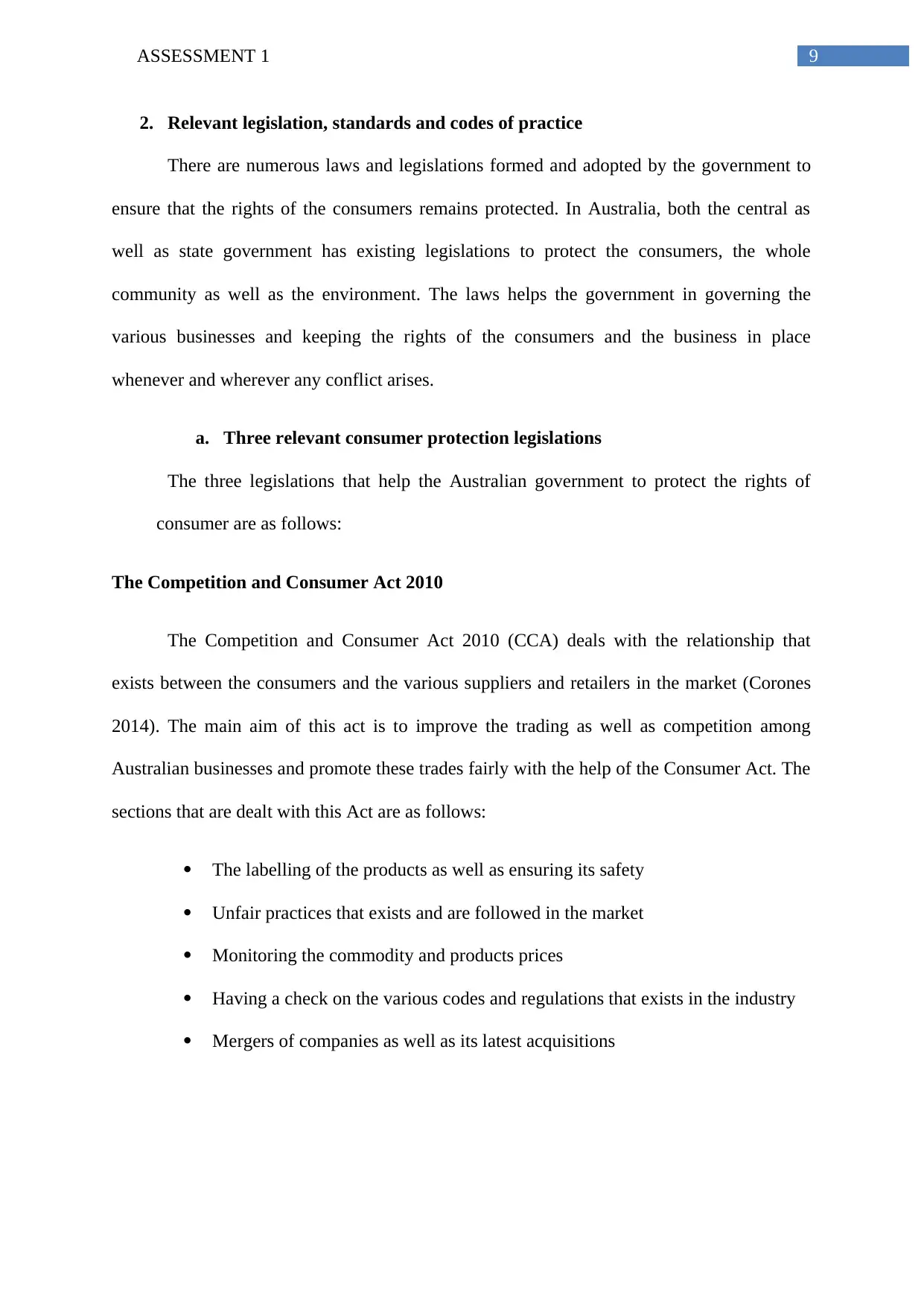
9ASSESSMENT 1
2. Relevant legislation, standards and codes of practice
There are numerous laws and legislations formed and adopted by the government to
ensure that the rights of the consumers remains protected. In Australia, both the central as
well as state government has existing legislations to protect the consumers, the whole
community as well as the environment. The laws helps the government in governing the
various businesses and keeping the rights of the consumers and the business in place
whenever and wherever any conflict arises.
a. Three relevant consumer protection legislations
The three legislations that help the Australian government to protect the rights of
consumer are as follows:
The Competition and Consumer Act 2010
The Competition and Consumer Act 2010 (CCA) deals with the relationship that
exists between the consumers and the various suppliers and retailers in the market (Corones
2014). The main aim of this act is to improve the trading as well as competition among
Australian businesses and promote these trades fairly with the help of the Consumer Act. The
sections that are dealt with this Act are as follows:
The labelling of the products as well as ensuring its safety
Unfair practices that exists and are followed in the market
Monitoring the commodity and products prices
Having a check on the various codes and regulations that exists in the industry
Mergers of companies as well as its latest acquisitions
2. Relevant legislation, standards and codes of practice
There are numerous laws and legislations formed and adopted by the government to
ensure that the rights of the consumers remains protected. In Australia, both the central as
well as state government has existing legislations to protect the consumers, the whole
community as well as the environment. The laws helps the government in governing the
various businesses and keeping the rights of the consumers and the business in place
whenever and wherever any conflict arises.
a. Three relevant consumer protection legislations
The three legislations that help the Australian government to protect the rights of
consumer are as follows:
The Competition and Consumer Act 2010
The Competition and Consumer Act 2010 (CCA) deals with the relationship that
exists between the consumers and the various suppliers and retailers in the market (Corones
2014). The main aim of this act is to improve the trading as well as competition among
Australian businesses and promote these trades fairly with the help of the Consumer Act. The
sections that are dealt with this Act are as follows:
The labelling of the products as well as ensuring its safety
Unfair practices that exists and are followed in the market
Monitoring the commodity and products prices
Having a check on the various codes and regulations that exists in the industry
Mergers of companies as well as its latest acquisitions
Paraphrase This Document
Need a fresh take? Get an instant paraphrase of this document with our AI Paraphraser
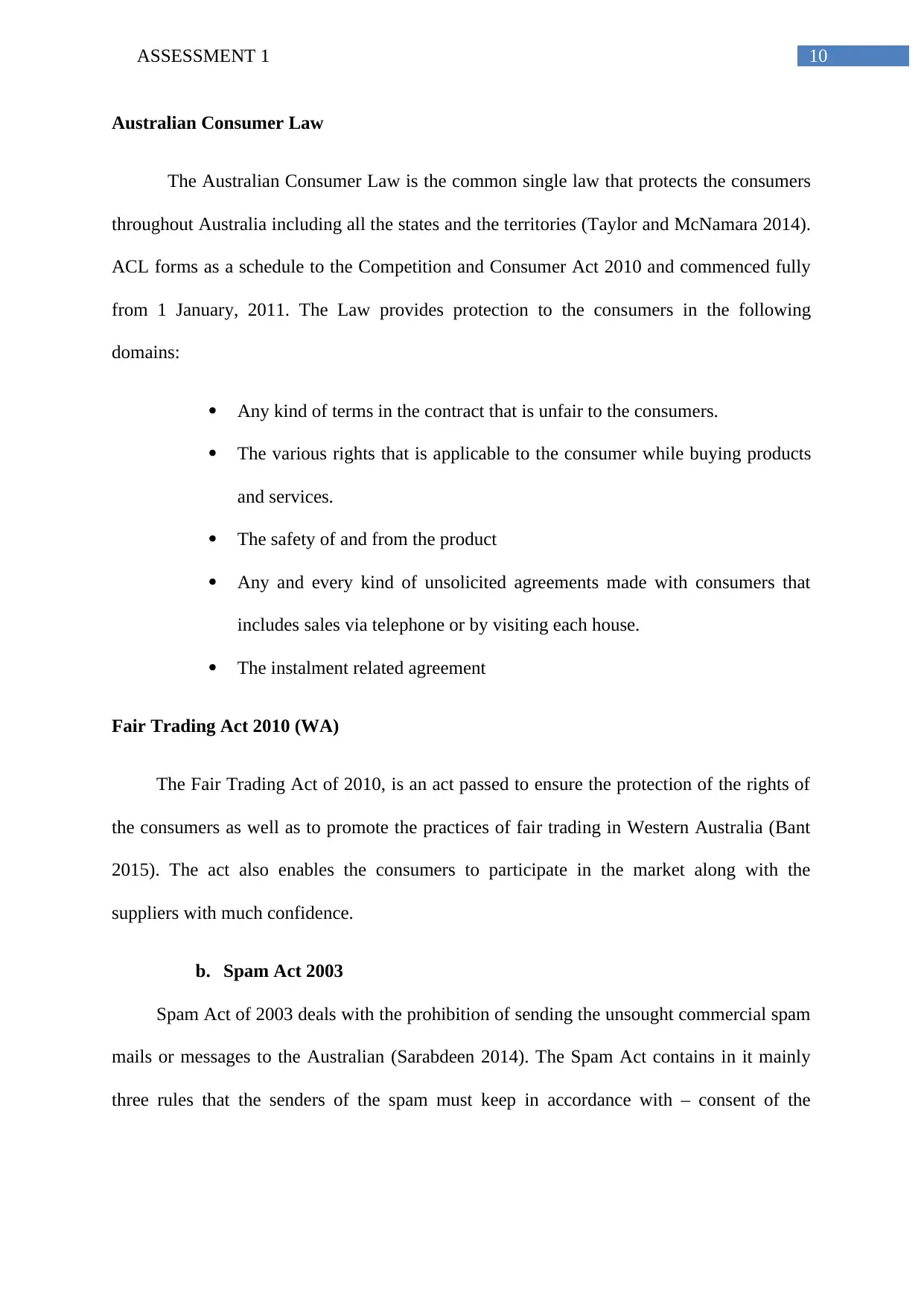
10ASSESSMENT 1
Australian Consumer Law
The Australian Consumer Law is the common single law that protects the consumers
throughout Australia including all the states and the territories (Taylor and McNamara 2014).
ACL forms as a schedule to the Competition and Consumer Act 2010 and commenced fully
from 1 January, 2011. The Law provides protection to the consumers in the following
domains:
Any kind of terms in the contract that is unfair to the consumers.
The various rights that is applicable to the consumer while buying products
and services.
The safety of and from the product
Any and every kind of unsolicited agreements made with consumers that
includes sales via telephone or by visiting each house.
The instalment related agreement
Fair Trading Act 2010 (WA)
The Fair Trading Act of 2010, is an act passed to ensure the protection of the rights of
the consumers as well as to promote the practices of fair trading in Western Australia (Bant
2015). The act also enables the consumers to participate in the market along with the
suppliers with much confidence.
b. Spam Act 2003
Spam Act of 2003 deals with the prohibition of sending the unsought commercial spam
mails or messages to the Australian (Sarabdeen 2014). The Spam Act contains in it mainly
three rules that the senders of the spam must keep in accordance with – consent of the
Australian Consumer Law
The Australian Consumer Law is the common single law that protects the consumers
throughout Australia including all the states and the territories (Taylor and McNamara 2014).
ACL forms as a schedule to the Competition and Consumer Act 2010 and commenced fully
from 1 January, 2011. The Law provides protection to the consumers in the following
domains:
Any kind of terms in the contract that is unfair to the consumers.
The various rights that is applicable to the consumer while buying products
and services.
The safety of and from the product
Any and every kind of unsolicited agreements made with consumers that
includes sales via telephone or by visiting each house.
The instalment related agreement
Fair Trading Act 2010 (WA)
The Fair Trading Act of 2010, is an act passed to ensure the protection of the rights of
the consumers as well as to promote the practices of fair trading in Western Australia (Bant
2015). The act also enables the consumers to participate in the market along with the
suppliers with much confidence.
b. Spam Act 2003
Spam Act of 2003 deals with the prohibition of sending the unsought commercial spam
mails or messages to the Australian (Sarabdeen 2014). The Spam Act contains in it mainly
three rules that the senders of the spam must keep in accordance with – consent of the
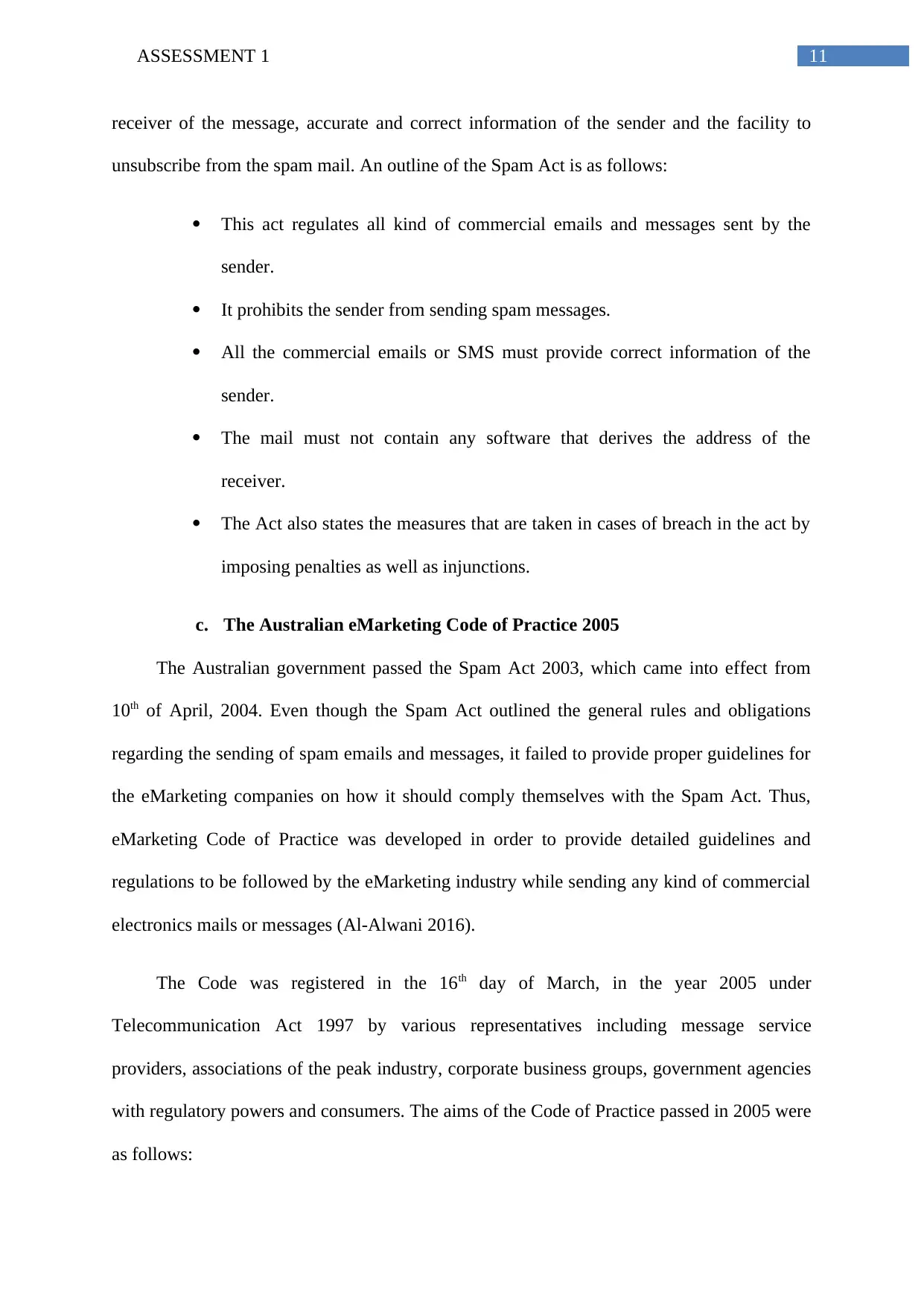
11ASSESSMENT 1
receiver of the message, accurate and correct information of the sender and the facility to
unsubscribe from the spam mail. An outline of the Spam Act is as follows:
This act regulates all kind of commercial emails and messages sent by the
sender.
It prohibits the sender from sending spam messages.
All the commercial emails or SMS must provide correct information of the
sender.
The mail must not contain any software that derives the address of the
receiver.
The Act also states the measures that are taken in cases of breach in the act by
imposing penalties as well as injunctions.
c. The Australian eMarketing Code of Practice 2005
The Australian government passed the Spam Act 2003, which came into effect from
10th of April, 2004. Even though the Spam Act outlined the general rules and obligations
regarding the sending of spam emails and messages, it failed to provide proper guidelines for
the eMarketing companies on how it should comply themselves with the Spam Act. Thus,
eMarketing Code of Practice was developed in order to provide detailed guidelines and
regulations to be followed by the eMarketing industry while sending any kind of commercial
electronics mails or messages (Al-Alwani 2016).
The Code was registered in the 16th day of March, in the year 2005 under
Telecommunication Act 1997 by various representatives including message service
providers, associations of the peak industry, corporate business groups, government agencies
with regulatory powers and consumers. The aims of the Code of Practice passed in 2005 were
as follows:
receiver of the message, accurate and correct information of the sender and the facility to
unsubscribe from the spam mail. An outline of the Spam Act is as follows:
This act regulates all kind of commercial emails and messages sent by the
sender.
It prohibits the sender from sending spam messages.
All the commercial emails or SMS must provide correct information of the
sender.
The mail must not contain any software that derives the address of the
receiver.
The Act also states the measures that are taken in cases of breach in the act by
imposing penalties as well as injunctions.
c. The Australian eMarketing Code of Practice 2005
The Australian government passed the Spam Act 2003, which came into effect from
10th of April, 2004. Even though the Spam Act outlined the general rules and obligations
regarding the sending of spam emails and messages, it failed to provide proper guidelines for
the eMarketing companies on how it should comply themselves with the Spam Act. Thus,
eMarketing Code of Practice was developed in order to provide detailed guidelines and
regulations to be followed by the eMarketing industry while sending any kind of commercial
electronics mails or messages (Al-Alwani 2016).
The Code was registered in the 16th day of March, in the year 2005 under
Telecommunication Act 1997 by various representatives including message service
providers, associations of the peak industry, corporate business groups, government agencies
with regulatory powers and consumers. The aims of the Code of Practice passed in 2005 were
as follows:
⊘ This is a preview!⊘
Do you want full access?
Subscribe today to unlock all pages.

Trusted by 1+ million students worldwide
1 out of 14
Related Documents
Your All-in-One AI-Powered Toolkit for Academic Success.
+13062052269
info@desklib.com
Available 24*7 on WhatsApp / Email
![[object Object]](/_next/static/media/star-bottom.7253800d.svg)
Unlock your academic potential
Copyright © 2020–2025 A2Z Services. All Rights Reserved. Developed and managed by ZUCOL.





